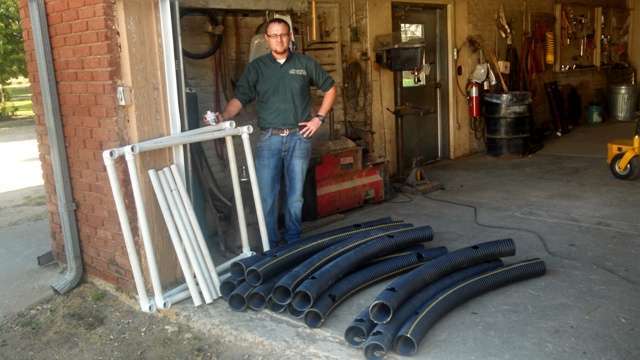 Ask any knowledgeable fisherman why they fish precisely where they do and their explanation will likely include the presence of some sort of underwater structure at their favorite honey holes. Fish are drawn to underwater structure for both security and for the smaller baitfish it also attracts. This structure can be as elaborate and extensive as sunken Christmas trees, underwater trees and brush piles or something as mundane as tree stumps and old building foundations.
Ask any knowledgeable fisherman why they fish precisely where they do and their explanation will likely include the presence of some sort of underwater structure at their favorite honey holes. Fish are drawn to underwater structure for both security and for the smaller baitfish it also attracts. This structure can be as elaborate and extensive as sunken Christmas trees, underwater trees and brush piles or something as mundane as tree stumps and old building foundations.
Traditionally Kansas Department of Wildlife, Parks and Tourism (KDWPT) biologists have used cut trees to make manmade brush piles, but this year they will begin a new program that uses a new and very different product to create additional fish attracting structures in Kansas lakes.
Developed by the Georgia Department of Natural Resources and known as Georgia Cubes, each structure is a square frame made from PVC pipe upon which plastic corrugated drain pipe is fastened. A 3 foot square “cube” is made from 1½ inch PVC pipe. Before the top pipes are put onto the cube, about 16 pounds of gravel is poured into the open pipes, making the cube heavy enough to sink to the bottom of the lake and stay where it’s put. Also before the top framework is added, holes are drilled in pieces of 4 inch plastic, corrugated drain pipe (like you would bury around your house for drainage) and pieces are slipped down over the upright pipes until a total of about fifty feet is added. The plastic drain pipe adds additional surface area to help attract fish, yet keeps the design open which seems to work best. Now the top PVC pipes are put on and the cube is ready to be submerged.
 The PVC cubes are cost-effective, easy to place and last three times longer than traditional tree-limb brush piles. In other states where they are in use, they have also proven to attract and hold just as many fish as manmade brush piles. Bryan Sowards, Fisheries Program Specialist for the state of Kansas says their goal is to produce and deploy 150 – 300 cubes per year. In 2015 Georgia Cubes will be placed in Milford, Wilson, Melvern, El Dorado and Cedar bluff reservoirs as well as in a variety of community and state fishing lakes. Biologists have also found that these structures quickly accumulate a complex mix of algae, fungi and bacteria known as periphyton, which attracts small fish and insects, which in turn attract bigger sport fish.
The PVC cubes are cost-effective, easy to place and last three times longer than traditional tree-limb brush piles. In other states where they are in use, they have also proven to attract and hold just as many fish as manmade brush piles. Bryan Sowards, Fisheries Program Specialist for the state of Kansas says their goal is to produce and deploy 150 – 300 cubes per year. In 2015 Georgia Cubes will be placed in Milford, Wilson, Melvern, El Dorado and Cedar bluff reservoirs as well as in a variety of community and state fishing lakes. Biologists have also found that these structures quickly accumulate a complex mix of algae, fungi and bacteria known as periphyton, which attracts small fish and insects, which in turn attract bigger sport fish.
Members of Kansas B.A.S.S. Nation Clubs will help distribute and deploy the finished cubes. Jeff Nolte, conservation director for the clubs adds that besides attracting and holding sport fish, the cubes also provide critical nursery habitat to help fry evade predator fish as they grow.
Once the cubes are submerged, they will be marked by GPS and added to a file available on the KDWPT website, www.ksoutdoors.com. Click on “fishing” at the top of the page, then click on “where to fish in Kansas” on the left hand side, then click on “Google KMZ file of fish attracters” and follow the directions. To me it all equals a win-win- situation for Kansas fishermen as our Kansas Dept. of Wildlife, Parks and Tourism helps us all Explore Kansas Outdoors!
Steve can be contacted by email at stevegilliland@idkcom.net.

